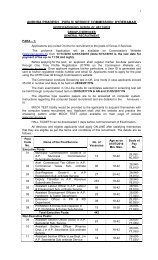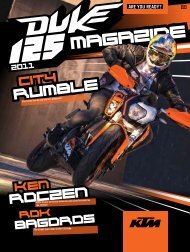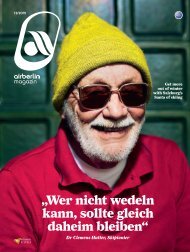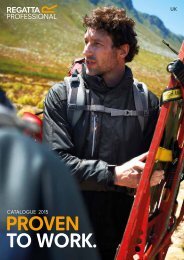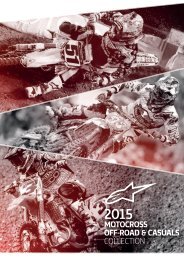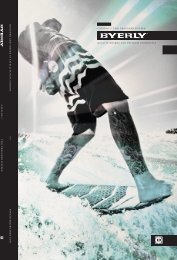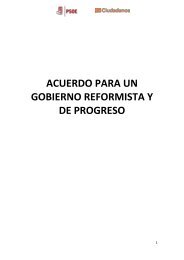onTrack
onTrack
onTrack
You also want an ePaper? Increase the reach of your titles
YUMPU automatically turns print PDFs into web optimized ePapers that Google loves.
The simple solution is not to exert your arms. Stop<br />
training, stop riding, and the symptoms go away<br />
after a certain time. For a MotoGP rider – or a<br />
motocross rider, as they suffer the problem even<br />
worse – that is simply not a solution. Changes<br />
in riding style can sometimes help: trying to ride<br />
more loosely, and loosening the grip on the bars.<br />
But that can also quickly lead to disaster, as the<br />
bike can more quickly get away from you completely,<br />
sending your for a painful tumble through<br />
the gravel. The most common solution is surgery,<br />
cutting the fascia which enclose the muscle fibres,<br />
literally giving them more room to expand. The<br />
forearms of most MotoGP riders already bear the<br />
scars of that operation. The success rate is far<br />
from 100%, however, and often it merely delays<br />
the reappearance of arm pump.<br />
To be forced to retire due to this complaint sounds<br />
ridiculous but it is the harsh reality of racing.<br />
Competing at the very highest level places unreal<br />
demands on the human body. Even the slightest<br />
weakness can mean the difference between finishing<br />
first or fifteenth. For racers, used to coping with<br />
pain from weekly crashes, it is hard to accept being<br />
restricted by vague and indefinable problems.<br />
For fans, accustomed to the sight of riders breaking<br />
arms, collarbones, legs and then climbing back<br />
in the saddle the very next day, seeing riders out<br />
with injuries which leave them still capable of walking<br />
around looking relatively healthy is positively<br />
mystifying.<br />
Riders who suffer such problems are often shocked<br />
to find fans heaping opprobrium upon them. When<br />
Ben Spies retired due to shoulder problems, the<br />
fans decried his weakness, pointing to the example<br />
of Valentino Rossi, riding just a few short weeks<br />
after suffering a double fracture of his lower leg.<br />
What the fans failed to take into account is the<br />
fact that the shoulder is both the most complex<br />
and the most fragile joint in the human body. The<br />
fact that we are capable of bowling a cricket ball<br />
or pitching a baseball is a miracle of evolutionary<br />
engineering, with bone attached loosely to socket<br />
by an intricate web of tendons, ligament, muscles<br />
and cartilage. It is easily damaged – especially<br />
when falling of a motorcycle at a hundred miles an<br />
hour – and very difficult to fix.<br />
Indeed, this joint came very close to ending Valentino<br />
Rossi’s career. After Qatar 2010, Rossi fell<br />
heavily while training, damaging the tissue in his<br />
shoulder. Treatment by Dr. Costa did not solve the<br />
problem, and Rossi rode all that year with a weak<br />
shoulder. Some believe that the shoulder contributed<br />
to his Mugello crash, as he tried to push too<br />
hard to catch Lorenzo in practice. Surgery at the<br />
end of 2010 was a success but even then it took<br />
nearly five months for him to be fully fit again. Unfortunately,<br />
by that stage, he was riding the Ducati<br />
…<br />
So spare a thought for Dani Pedrosa, as you revel<br />
in the afterglow of one of the best MotoGP races<br />
since, well, probably since Qatar last year. The<br />
Spaniard has had an astonishing career – he has<br />
more premier class wins than Schwantz, Rainey,<br />
Spencer, Roberts, Surtees, and is eighth in total<br />
wins in all classes – and has survived some incredible<br />
setbacks. He has been bruised, battered,<br />
and broken bones in almost every part of his body.<br />
He has been thrown from his bike when his throttle<br />
stuck open, a terrifying experience for anyone.<br />
He has come back from all of these blows, and<br />
gone on to win at the very highest level. Despite<br />
intense pain and no strength or feeling in his right<br />
hand – a motorcycle racer’s most important limb<br />
– he beat 19 other riders, and finished within ten<br />
seconds of the man many regard as the greatest<br />
motorcycle racer in history. Now, he could be laid<br />
low by a bundle of fibres in his arm. If he is forced<br />
to retire, it will not be for lack of courage.




